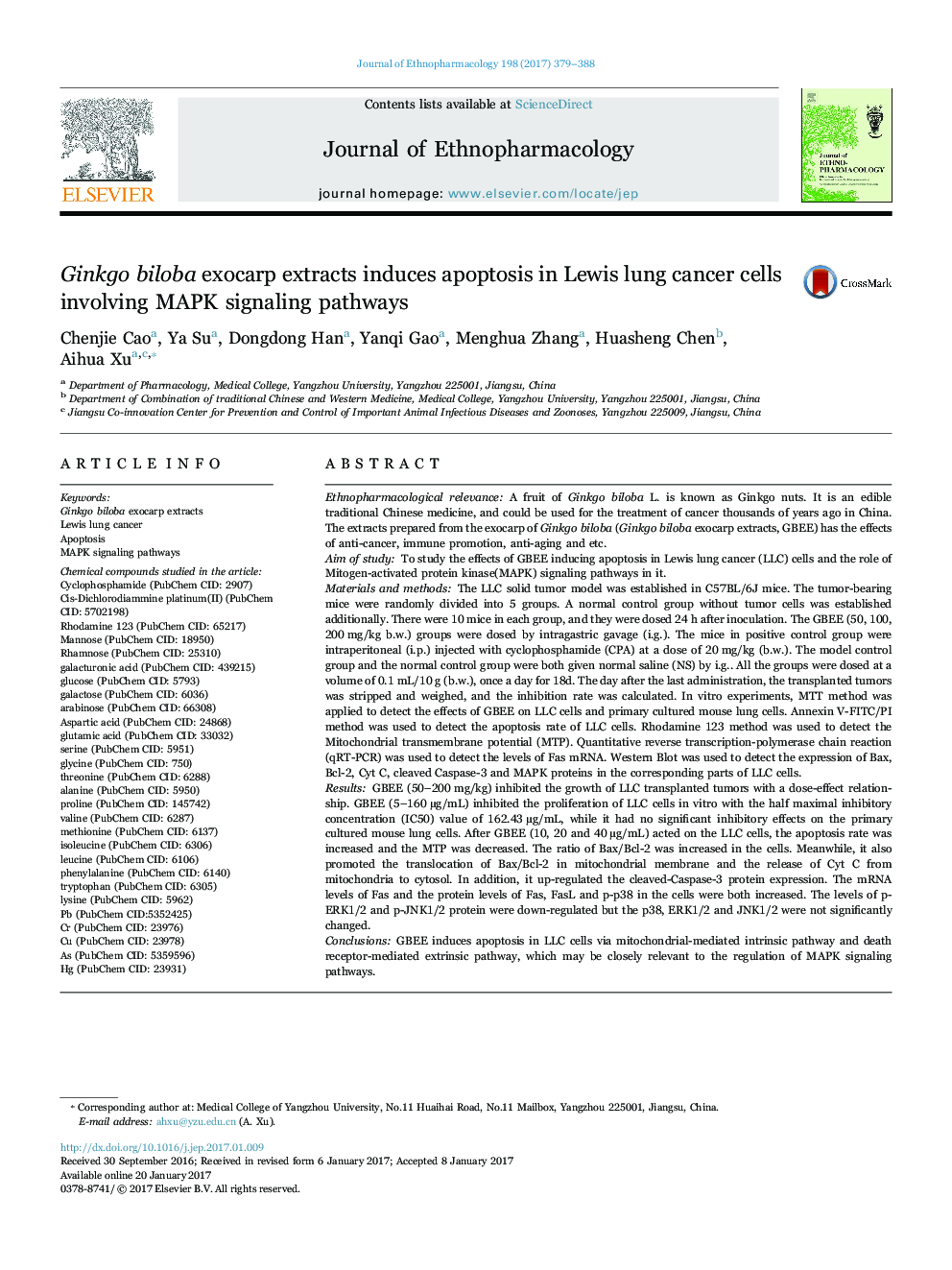| Article ID | Journal | Published Year | Pages | File Type |
|---|---|---|---|---|
| 5556342 | Journal of Ethnopharmacology | 2017 | 10 Pages |
Ethnopharmacological relevanceA fruit of Ginkgo biloba L. is known as Ginkgo nuts. It is an edible traditional Chinese medicine, and could be used for the treatment of cancer thousands of years ago in China. The extracts prepared from the exocarp of Ginkgo biloba (Ginkgo biloba exocarp extracts, GBEE) has the effects of anti-cancer, immune promotion, anti-aging and etc.Aim of studyTo study the effects of GBEE inducing apoptosis in Lewis lung cancer (LLC) cells and the role of Mitogen-activated protein kinase(MAPK) signaling pathways in it.Materials and methodsThe LLC solid tumor model was established in C57BL/6J mice. The tumor-bearing mice were randomly divided into 5 groups. A normal control group without tumor cells was established additionally. There were 10 mice in each group, and they were dosed 24 h after inoculation. The GBEE (50, 100, 200 mg/kg b.w.) groups were dosed by intragastric gavage (i.g.). The mice in positive control group were intraperitoneal (i.p.) injected with cyclophosphamide (CPA) at a dose of 20 mg/kg (b.w.). The model control group and the normal control group were both given normal saline (NS) by i.g.. All the groups were dosed at a volume of 0.1 mL/10 g (b.w.), once a day for 18d. The day after the last administration, the transplanted tumors was stripped and weighed, and the inhibition rate was calculated. In vitro experiments, MTT method was applied to detect the effects of GBEE on LLC cells and primary cultured mouse lung cells. Annexin V-FITC/PI method was used to detect the apoptosis rate of LLC cells. Rhodamine 123 method was used to detect the Mitochondrial transmembrane potential (MTP). Quantitative reverse transcription-polymerase chain reaction (qRT-PCR) was used to detect the levels of Fas mRNA. Western Blot was used to detect the expression of Bax, Bcl-2, Cyt C, cleaved Caspase-3 and MAPK proteins in the corresponding parts of LLC cells.ResultsGBEE (50-200 mg/kg) inhibited the growth of LLC transplanted tumors with a dose-effect relationship. GBEE (5-160 µg/mL) inhibited the proliferation of LLC cells in vitro with the half maximal inhibitory concentration (IC50) value of 162.43 µg/mL, while it had no significant inhibitory effects on the primary cultured mouse lung cells. After GBEE (10, 20 and 40 µg/mL) acted on the LLC cells, the apoptosis rate was increased and the MTP was decreased. The ratio of Bax/Bcl-2 was increased in the cells. Meanwhile, it also promoted the translocation of Bax/Bcl-2 in mitochondrial membrane and the release of Cyt C from mitochondria to cytosol. In addition, it up-regulated the cleaved-Caspase-3 protein expression. The mRNA levels of Fas and the protein levels of Fas, FasL and p-p38 in the cells were both increased. The levels of p-ERK1/2 and p-JNK1/2 protein were down-regulated but the p38, ERK1/2 and JNK1/2 were not significantly changed.ConclusionsGBEE induces apoptosis in LLC cells via mitochondrial-mediated intrinsic pathway and death receptor-mediated extrinsic pathway, which may be closely relevant to the regulation of MAPK signaling pathways.
Graphical abstractDownload high-res image (189KB)Download full-size image
